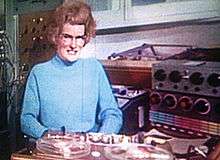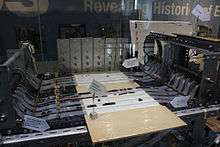Daphne Oram
| Daphne Oram | |
|---|---|
 | |
| Background information | |
| Birth name | Daphne Blake Oram |
| Born |
31 December 1925 Devizes, Wiltshire, UK |
| Died |
5 January 2003 (aged 77) Maidstone, Kent, UK |
| Genres | Electronic music |
| Occupation(s) | Composer, electronic musician |
| Instruments | Musique concrète, Synthesisers |
| Associated acts | BBC Radiophonic Workshop |
| Notable instruments | |
| Oramics synthesiser | |
Daphne Oram (31 December 1925 – 5 January 2003) was a British composer and electronic musician. She was the creator of the "Oramics" technique for creating electronic sounds.
Early life
Educated at Sherborne School For Girls, Oram was, from an early age, taught piano and organ as well as musical composition.[1]
Career
Work at the BBC
In 1942 Oram was offered a place at the Royal College of Music but instead took up a position as a Junior Studio Engineer and "music balancer" at the BBC.[2] During this period she became aware of developments in synthetic sound and began experimenting with tape recorders. She also spent some time in the 1940s composing music, which remained unperformed, including an orchestal work entitled Still Point.[1] In the 1950s she was promoted to become a music studio manager and, following a trip to the RTF studios in Paris, began to campaign for the BBC to provide electronic music facilities for composing sounds and music, using electronic music and musique concrète techniques, for use in its programming.[2] In 1957 she was commissioned to compose music for the play Amphitryon 38. Using a sine wave oscillator, a tape recorder and some self-designed filters, she produced the score from only electronic sources; the first of its kind at the BBC.[2] Along with fellow electronic musician and BBC colleague Desmond Briscoe, she began to receive commissions for many other works - including a significant production of Samuel Beckett’s All That Fall. As demand grew for these electronic sounds, the BBC gave Oram and Briscoe a budget to establish the BBC Radiophonic Workshop in early 1958, where she was the first Studio Manager.[2] In October of that year, she was sent by the BBC to the "Journées Internationales de Musique Expérimentale" at the Brussels World’s Fair (where Edgard Varèse demonstrated his Poème électronique). After hearing some of the work produced by her contemporaries and being unhappy at the BBC's music department's lack of interest, she decided to resign from the BBC less than one year after the workshop was opened, hoping to develop her techniques further on her own.[1][3]
Oramics
In 1959 she installed her Oramics Studios for Electronic Composition in Tower Folly, a converted oast house at Fairseat, near Wrotham, Kent. Her output from the studio, mostly commercial, covered a far wider range than the Radiophonic Workshop, providing background music for not only radio and television but also theatre and short commercial films. She was also commissioned to provide sounds for installations and exhibitions. Other work from this studio included electronic sounds for Jack Clayton's 1961 horror film The Innocents, concert works including Four Aspects and collaborations with opera composer Thea Musgrave and Ivor Walsworth.[4]

In February 1962, she was awarded a grant of £3,550 (equivalent to £68,000 in 2015)[5] from the Gulbenkian Foundation to support the developments and research of her "Oramics" drawn sound technique. This method of music composition and performance was intended by Oram to allow a composer to be able to draw an "alphabet of symbols" on paper and feed it through a machine that would, in turn, produce the relevant sounds on magnetic tape.[6] A second Gulbenkian grant of £1,000, awarded in 1965, enabled the Oramics composition machine to be completed.[3] The first drawn sound composition using the machine, entitled "Contrasts Essonic", was recorded in 1968.[7]
In the 1980s Oram worked on the development of a software version of Oramics for the Acorn Archimedes computer.[1]
Other Achievements
Throughout her career she lectured on electronic music and studio techniques. In 1972 she wrote An Individual Note of Music, Sound and Electronics which investigated electronic music in a philosophical manner. Besides being a musical innovator her other significant achievements include being the first woman to direct an electronic music studio, the first woman to set up a personal studio and the first woman to design and construct an electronic musical instrument.[4]
Death
In the 1990s, she suffered two strokes and was forced to stop working, later moving to a nursing home. She died in 2003 at age 77.
Archive
After Oram's death a large archive relating to her life's work was passed to the composer Hugh Davies. When Davies died in 2005 this material passed to the Sonic Arts Network. In 2008 the archive was deposited at the Music Department of Goldsmiths, University of London, where it is open for public access and ongoing research.[8] The launch of the archive was celebrated with a symposium and a series of concerts at the Southbank Centre.[9] This included a concert of newly reworked versions of material from the collection by music collage artist People Like Us.[10]
In 2007, a compilation of her music, entitled Oramics, was released.[11]
In 2008, a BBC Radio 3 documentary on her life was broadcast as part of the Sunday Feature strand entitled Wee Have Also Sound-Houses.[12]
The Wire
A very detailed feature on Daphne Oram's musical philosophy was published in the August 2011 issue of The Wire magazine.
Click tribute
In its first show of 2012, the BBC television technology programme Click featured a piece about Daphne Oram and her synthesiser, mainly prompted by the three-part Oramics Machine being on display at the Science Museum, London, during a year-long exhibition on the history of electronic music. It showed the machine being installed in a large display cabinet, and described how it was no longer possible to play due to its fragile state; however, an interactive, virtual version of the machine has been created, which allows visitors to create their own compositions. The programme showed archive footage of Oram describing the process of what became 'Oramics', also showing her 'drawing' the music, then playing her machine. The piece was entirely positive and described her as an 'unsung hero' of electronic music.
Discography
- Electronic Sound Patterns (1962) single,[13] also included on Listen, Move and Dance Volume 1 from same year with work from Vera Gray[14]
- Oramics (2007) compilation on Paradigm Discs[15]
- Spaceship UK: The Untold Story Of The British Space Programme (2010) promotional 7" split single with Belbury Poly[16]
- Private Dreams and Public Nightmares (2011) remix album by Andrea Parker (DJ) and Daz Quayle on Aperture[17]
- The Oram Tapes: Volume 1 (2011) compilation on Young Americans[18]
- Sound Houses (2014) remix album by Walls (band)[19]
- Pop Tryouts (2015) mini album on cassette and download on Was Ist Das?[20]
Publication
- Oram, Daphne (1972). An Individual Note - of music, sound and electronics. London: Galliard. ISBN 0852491093.
References
- 1 2 3 4 Davies, Hugh (24 January 2003). "Obituary: Daphne Oram". The Guardian.
- 1 2 3 4 "The Oram Archive - BBC". Daphneoram.org. 2008. Retrieved 14 August 2008.
- 1 2 Davies, Hugh. "Daphne Oram: A Tribute to a Pioneer". Sonic Arts Network. Archived from the original on 10 February 2006. Retrieved 14 August 2008.
- 1 2 "Daphne Oram". Sonic Arts Network. Archived from the original on 21 September 2008. Retrieved 14 August 2008.
- ↑ UK CPI inflation numbers based on data available from Gregory Clark (2016), "The Annual RPI and Average Earnings for Britain, 1209 to Present (New Series)" MeasuringWorth.
- ↑ "The Oram Archive - Oramics". Daphneoram.org. 2008. Retrieved 14 August 2008.
- ↑ Pinsent, Ed (2007). "Oramics Review". The Sound Projector. Retrieved 14 August 2008.
- ↑ Daphne Oram Trust
- ↑ "Electronic Music Studios - Archived News & Events: 2008 - 2009". Goldsmiths, University of London. Retrieved 27 March 2015.
- ↑ "People Like Us incoming MP3s". WFMU. 5 August 2008. Retrieved 4 May 2009.
- ↑ Paradigm discs information about album
- ↑ "BBC Radio 3 Programmes - Sunday Feature: Wee Have Also Sound-Houses". BBC. Retrieved 6 January 2009.
- ↑ http://www.discogs.com/Daphne-Oram-Electronic-Sound-Patterns/release/929220
- ↑ http://www.discogs.com/Daphne-Oram-Vera-Gray-Listen-Move-And-Dance-Volume-1/release/929222
- ↑ http://www.stalk.net/paradigm/pd21.html
- ↑ http://www.soundandmusic.org/projects/spaceship-uk
- ↑ http://www.andreaparker.co.uk/showcase/normal/private-dreams-and-public-nightmares
- ↑ https://boomkat.com/vinyl/473521-daphne-oram-the-oram-tapes-volume-one
- ↑ http://thequietus.com/articles/15317-walls-interview-daphne-oram
- ↑ http://wasistdas.co.uk/label/daphne-oram-pop-tryouts/
External links
- Daphne Oram Archive website
- Daphne Oram: A Tribute to a Pioneer at the Wayback Machine (archived 10 February 2006)
- Daphne Oram and "Oramics", 120years.net
- Obituary from The Independent
- Obituary from The Guardian
- Daphne Oram: Portrait of an electronic music pioneer from The Guardian
- BBC News story: Daphne Oram, the unsung pioneer of techno
- "Radiophonic Ladies" at the Wayback Machine (archived 17 May 2006)
- Daphne Oram at the Internet Movie Database